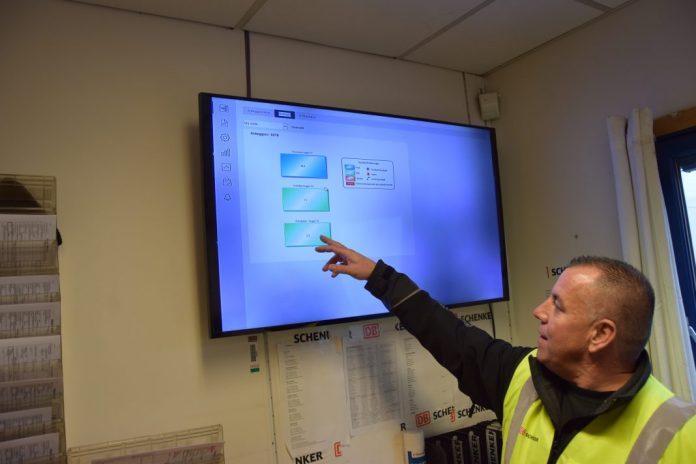When it leaves, it’ll arrive, but perhaps what’s most of all is the temperature in the container or semi-trailer. Everything is monitored in Schenker’s various applications and systems where they monitor all aspects of salmon transport. Not only when they are in the office, but also on the mobile phone.
At the reception of the thermoterminal at Schenker, Alnabru (Oslo’s main cargo yard), a driver receives the required transport papers before driving somewhere Europe. A little further into the room are the shift leaders, they are responsible for everything going on in the cold store. Both of incoming and outgoing salmon.
Behind the office crowd is team leader, Bjørnar Lie. He has worked here for 18 years and started as one of the guys on the floor, but has worked for years in the system. He knows very well how things work here at the terminal. In recent years, more and more systems have given them more control of salmon transport.
Lie stands up and goes to a flat screen hanging on the wall. He points and shows several different screenshots. One shows the temperature inside the cold storage. Another shows an overview of Schenkers material with temperature and other necessary information.
“We can now also see all of this on the mobile,” Lie says, finding a mobile from his pocket and showing the same screens on the device.
If something goes wrong, we will be notified immediately
It’s not just the trucks Schenker is watching carefully. Perhaps most important is to follow the train that goes from Narvik in the north to Oslo in the south.
“If something happens to the trucks, they are on the road, and help is not far away. If something happens to the train, there are more measures that need to be taken. If there is a problem with an aggregate, we must first try to recover it from Oslo. At worst, the driver must receive immediate notice so that he can reboot the unit locally so that the fish is not lost,” said Elisabeth Nordeng, chief of Schenker’s “Thermo” cold storage transport unit.
Schenker has been using the system of monitoring and alarm if the temperature falls in the units for several years. But it’s only four years since they were given the opportunity to remotely control the units from the office.

External challenges also offer trouble
Nordeng is located on the second floor of the cold storage terminal. Here she sits together with 20 people who, among other things, handle all export and customs papers, and take care of all other conceivable aspects of transport. The team can follow salmon transport process minute by minute.
But everything does not always go as planned. In the far north of Norway, not everything is always as easy with the weather.
“There may be challenges that pertain to the entire train, such as breakdowns or too much snow on the tracks. Then the system is set up to send notifications to all affected customers,” Nordeng said to SalmonBusiness.
At the same time they are working on what opportunities they have in order to offer further solutions to bring fish to the customer.
“There may be express solutions with an additional driver from Oslo or, at worst, crane of the train along the way and send tractors to pick up loads down to Oslo. Fortunately, we have not had to resort to the latter option lately, but it has happened,” explained Nordeng.
And the technology is very helpful, says Lie, who has been in the industry for many years.
“There is no doubt that it provides extra security. Now we have full control of the salmon from A to B,” said Lie.


